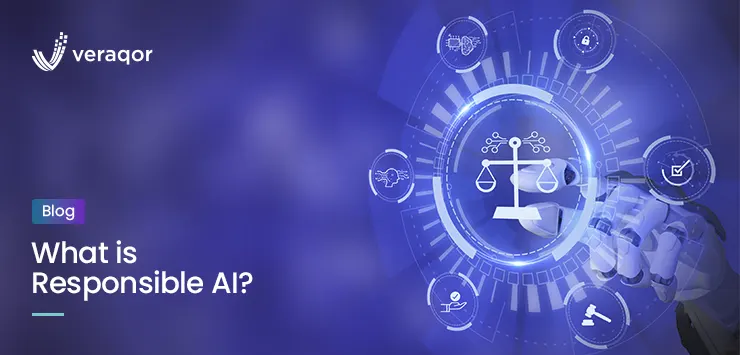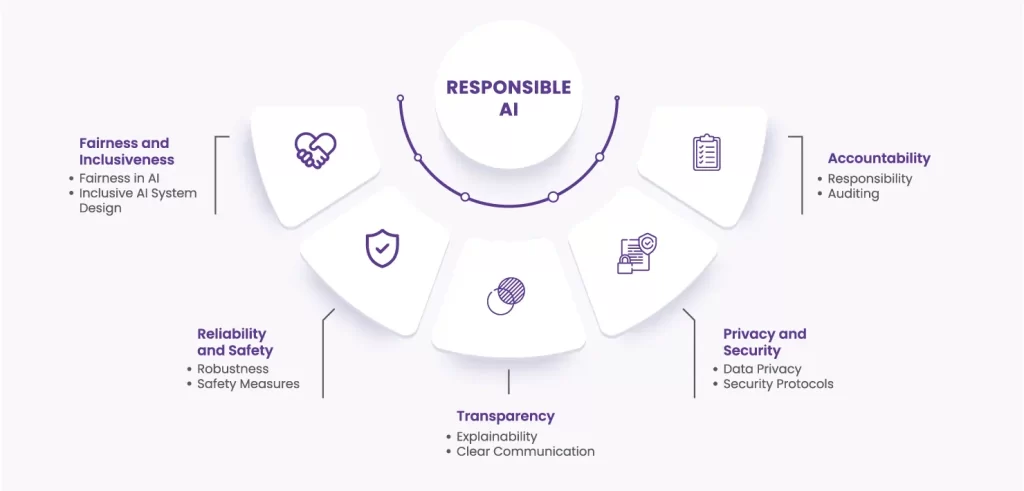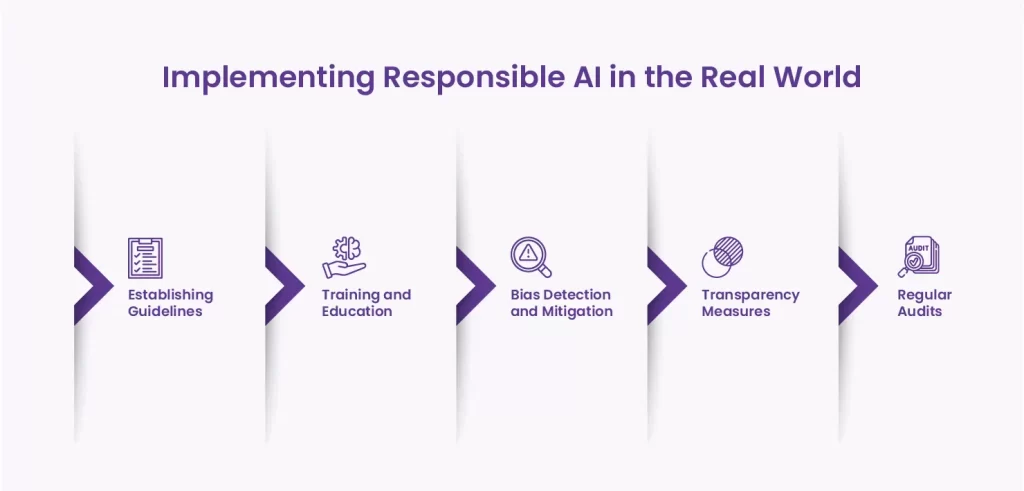Imagine a world where AI-powered doctors diagnose diseases with pinpoint accuracy or self-driving cars navigate bustling cityscapes with zero accidents. It would have been a fairytale a few years ago. Today, it is a different story.
Artificial intelligence (AI) is no longer science fiction and not just a buzzword – AI is rapidly transforming our lives. But with this immense power comes immense responsibility.
Just like harnessing electricity revolutionized society, it also necessitated safety measures to prevent fires and electrocutions. AI needs to be regulated as well.
That is why ensuring the ethical and responsible development and use of AI is critical.
Research carried out by Statista shows that nearly 99% of companies in Europe and North America have implemented some level of responsible AI practices in the year 2024. While Asia and Latin America have a higher overall adoption rate of AI projects, many still lack responsible AI measures.
Through this comprehensive guide on responsible AI development and usage, our aim is to help you understand what it is and why the increased use of artificial intelligence demands improved due diligence.
Let’s dive right in!
What is Responsible AI?
Responsible AI refers to the development and deployment of AI systems that are legal, ethical, transparent, and aligned with societal values.
It involves creating AI solutions that not only perform effectively but also adhere to principles such as fairness, accountability, privacy, and others. Responsible AI ensures that the technology benefits all users without causing harm or reinforcing biases.
In the early days, the concept of responsible or ethical AI did not bother anyone, but as time passed, it has now become a concern. For decision-makers and regulators across industries, the development of safe and fool-proof systems is a necessity.
Why is Responsible AI Important, and What Are Its Benefits?
As artificial intelligence is becoming more and more common around us, penetrating our daily chores and assisting us in going about our business, it is hard to neglect or overlook the safety assurance side.
There are multiple benefits of responsible AI development. Mainly, responsible AI practices help plan better for contingencies, negate or handle biases (that can turn bad), and build a culture of transparency and trust for a positive impact on society.
Here are several reasons why responsible AI is paramount:
Trust and Adoption
AI systems built with a focus on responsibility are more likely to gain the trust of users. This trust is crucial for the broader adoption of AI technologies across various sectors.
When users believe that AI operates transparently and ethically, they are more inclined to integrate these systems into their daily operations. This increased trust and adoption can lead to positive societal impacts, such as improved efficiencies in healthcare, finance, and education.
Trust is the cornerstone of AI’s success, and responsible AI practices ensure that AI remains a reliable partner in innovation.
Ethical Considerations
Responsible AI helps align AI development with ethical standards. By adhering to ethical principles, AI systems are designed to respect human rights and avoid perpetuating harmful biases.
This alignment ensures that AI technologies contribute positively to society. Ethical AI development focuses on creating systems that are fair and just, preventing discrimination and ensuring equal treatment for all users.
This approach not only protects individuals but also enhances the credibility and acceptance of AI solutions.
Compliance & Regulations
Adhering to responsible AI practices is essential for regulatory compliance. Various regions have stringent regulations governing data privacy, security, and ethical AI use. By following these guidelines, organizations can avoid legal risks and penalties.
Compliance ensures that AI systems are developed and deployed within the legal frameworks established by authorities. It also promotes accountability, as organizations are required to document and justify their AI practices.
This regulatory adherence builds a safer and more predictable environment for AI deployment.
Long-term Viability
Responsible AI fosters sustainable AI development, ensuring that AI systems remain beneficial over time. Sustainability in AI means developing technologies and intelligent solutions that can adapt and evolve without causing long-term harm.
Responsible AI practices encourage the creation of robust and resilient systems that can handle future challenges. By focusing on sustainability, organizations can ensure that their AI solutions contribute to continuous improvement and innovation.
This long-term viability helps in maintaining the relevance and effectiveness of AI technologies in various applications.
What are Some Potential Risks of AI?
There are some very real risks of unregulated AI development and implementation, but not all of them involve killer robots taking over humanity. Rather, the risks at hand include AI generating false results that can be acted upon by the masses, leading to unlikely results.
Here are some potential risks of irresponsible AI or unregulated AI development:
Bias and Discrimination
Artificial Intelligence systems, if not closely monitored, can perpetuate and even exacerbate existing biases. This happens because AI models often learn from historical data, which may contain inherent biases.
For instance, biased hiring practices in the past can lead to AI systems unfairly disadvantaging certain groups in recruitment processes. Addressing this issue requires implementing robust bias detection and mitigation strategies, ensuring AI fairness and inclusivity.
Privacy Violations
AI systems frequently depend on vast amounts of data to function effectively, which raises significant concerns about data privacy and security.
The collection, storage, and processing of personal information can lead to privacy infringements if not managed properly. High-profile incidents like the Cambridge Analytica scandal highlight the risks of data misuse.
Adhering to data protection regulations such as GDPR is crucial to safeguarding user privacy.
Lack of Transparency
Many AI models, especially those based on deep learning, operate as “black boxes,” making it difficult to understand their decision-making processes.
This opacity can undermine trust and accountability, as users and stakeholders are left in the dark about how conclusions are reached. Enhancing AI transparency through explainable AI techniques is essential for building trust and ensuring ethical AI practices.
Job Displacement
The automation of various tasks through AI can lead to significant job displacement, exacerbating economic inequality. While AI can increase efficiency and productivity, it may also render certain job roles obsolete.
According to a McKinsey report, around 14% of the global workforce might need to transition to new occupations by 2030 due to automation. Preparing the workforce for this shift through reskilling and upskilling initiatives is vital.
Security Threats
AI technologies can be exploited for malicious purposes, posing significant security threats.
For example, cybercriminals can use AI to conduct sophisticated cyberattacks, while deepfake technology can create realistic but false content, undermining trust and spreading misinformation.
Implementing robust security measures and developing AI systems with built-in safeguards are essential to mitigate these risks and ensure the responsible use of AI.
Future security risks are not just related to getting hacked but also to the increasing use of unhinged AI solutions. Technology enablers need to look beyond conventional parameters to keep things in check.
Core Principles of Responsible AI
Responsible AI development stands on a few principles, also known as core principles of responsible AI. Let’s have a look at them and understand what they mean.
Fairness and Inclusiveness
Fairness in AI
Ensuring AI systems do not discriminate against individuals or groups is crucial. Techniques to detect and mitigate biases in AI models are essential. Implementing algorithms and processes that identify and reduce bias can prevent discriminatory outcomes.
For example, Google’s Responsible AI practices include guidelines for detecting and mitigating bias to ensure fairness in AI systems.
Inclusive AI System Design
Designing AI systems to be accessible and beneficial to diverse user groups is another critical aspect. This involves considering various user needs and ensuring the AI system accommodates them.
By adopting inclusive design principles, AI developers can create technology that serves a broader audience, promoting equity and inclusivity.
Reliability and Safety
Robustness
AI systems must handle errors and uncertainties in data to be reliable. Robustness ensures that AI systems can perform accurately under diverse and unexpected conditions.
Techniques such as stress testing and scenario analysis can help identify and address potential weaknesses in AI models, enhancing their reliability.
Safety Measures
Implementing safeguards to prevent AI systems from causing harm is vital. This includes developing fail-safes and monitoring mechanisms that can detect and respond to harmful actions or decisions made by AI systems.
For example, autonomous vehicles must adhere to strict safety standards to ensure passenger and pedestrian safety.
Transparency
Explainability
Making AI models interpretable allows users to understand how decisions are made. Explainability helps build trust and enables users to scrutinize and validate AI decisions.
Techniques such as model interpretability tools and visualization can make AI decision-making processes more transparent.
Clear Communication
Providing clear information about the AI system’s capabilities and limitations is essential. Transparency in communication ensures that users and stakeholders are fully informed about what the AI system can and cannot do, which helps manage expectations and fosters trust.
Privacy and Security
Data Privacy
Adhering to data privacy regulations and best practices ensures that AI systems protect user data. Compliance with frameworks like the General Data Protection Regulation (GDPR) is crucial for maintaining data privacy.
This involves implementing data anonymization, encryption, and secure data handling practices.
Security Protocols
Strong security measures are necessary to protect data from breaches. This includes using advanced encryption techniques, regular security audits, and implementing robust access control mechanisms.
Ensuring data security helps prevent unauthorized access and protects sensitive information.
Accountability
Responsibility
There must be a clear line of responsibility for AI decisions. Defining who is accountable for the outcomes of AI decisions ensures that there is a mechanism for addressing any issues or errors that arise.
Organizations like IBM have established AI Ethics boards to oversee AI accountability.
Auditing
Regular audits ensure compliance with ethical standards. Implementing processes to periodically review AI systems for ethical compliance helps maintain responsible AI practices.
Audits can identify potential issues and areas for improvement, ensuring that AI systems continue to operate ethically and responsibly.
Responsible AI Vs. Ethical AI
While often used interchangeably, Responsible AI and Ethical AI have distinct focuses. These are two different terms, having two different meanings and contexts.
Ethical AI emphasizes the moral principles guiding AI development, while Responsible AI encompasses a broader framework, including practical implementation and adherence to legal and societal norms.
Ethical AI is a subset of Responsible AI, which also includes accountability, transparency, and inclusiveness.
Implementing Responsible AI in the Real World
Talking about responsible AI is of no good if it doesn’t get implemented and has real-world use cases. So, what needs to be done to properly implement responsible AI practices? Let’s find out.
Establishing Guidelines
To implement Responsible AI, start by developing clear guidelines and policies. These guidelines should outline ethical standards and compliance requirements.
They provide a framework for developers, ensuring AI systems are built and used responsibly.
Companies like Google and Microsoft have published their AI ethics guidelines, serving as excellent examples. Establishing such policies helps maintain consistency and sets a clear direction for all AI-related activities.
Training and Education
Educating stakeholders on responsible AI practices is crucial. This includes training AI developers, managers, and end-users about ethical AI principles.
Regular workshops and courses can help ensure everyone understands the importance of fairness, transparency, and accountability in AI. According to a survey by PwC, companies that invest in AI education see higher trust levels and better AI adoption rates.
Continuous education keeps everyone informed about the latest best practices and technological advancements.
Bias Detection and Mitigation
Identifying and mitigating biases in AI models is a critical step. Use tools like IBM’s AI Fairness 360 or Google’s What-If Tool to detect bias. Regularly test AI systems to ensure they do not perpetuate or amplify existing biases.
Implementing these tools can help create fairer and more inclusive AI applications. Research from MIT shows that addressing bias in AI can significantly improve the system’s accuracy and fairness, leading to more equitable outcomes.
Transparency Measures
Enhancing transparency in AI systems involves making AI models explainable. Users should understand how AI decisions are made.
Techniques such as model interpretability and explainable AI (XAI) can help achieve this. Providing clear documentation and communication about AI capabilities and limitations is essential.
Transparent AI systems build and maintain trust among users and stakeholders, as highlighted in the European Commission’s guidelines on trustworthy AI.
Regular Audits
Conducting regular audits is essential to ensure AI systems comply with established guidelines. These audits should evaluate the AI’s performance, fairness, and ethical alignment.
Third-party audits can provide an unbiased assessment and identify areas for improvement. Regular audits help maintain accountability and transparency, ensuring AI systems continue to operate responsibly.
According to a report by Deloitte, regular AI audits are instrumental in maintaining compliance and fostering trust.
Conclusion
More than AI, maybe we need to talk more about responsible AI development. The idea of making this world a better place, driven by artificial intelligence, is very bright. But like many other weapons, AI is a two-edged sword.
AI engines and models that we see today are all backed by data. And data can be wrong, it can be without context, or it can be skewed. And if that is not known, the results can be devastating to say the least.
For this, responsible AI practices are the need of the hour. No matter if you are a big tech firm, a modern tech regulator, or just an aspiring engineer, the understanding of responsible artificial intelligence is paramount.





